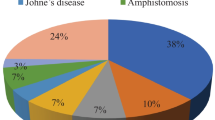Abstract
The objective of this study was to evaluate the value of some haematological and serum biochemical constituents for predicting the survival of diarrhoeic calves. Twenty-four Holstein-breed calves, up to 14 days old, that showed signs of naturally occurring diarrhoea were included in the study. A complete clinical evaluation was performed before treatment. Haematological parameters (haematocrit, fibrinogen and complete blood count) and serum biochemistry including serum albumin, glucose, blood urea nitrogen (BUN), creatinine, sodium (Na), potassium (K) and chloride (Cl) were measured. The diarrhoeic calves had significantly higher serum concentrations of total protein, BUN, creatinine and K and significantly lower levels of serum glucose and Cl than the control calves. The haematological profile of diarrhoeic calves was significantly different from that of the normal ones. The concentration of K was also significantly higher in diarrhoeic calves that died than in diarrhoeic calves that survived. We assessed the values of haematocrit, BUN, creatinine and K as risk factors for calf diarrhoea survival. The mean of maximum values of these parameters in diarrhoeic calves that survived and the minimum values of dead calves were considered as cutoff points. The results of the present study showed that diarrhoeic calves with BUN levels above 13.07 mmol/l and K concentrations above 5.63 mEq/l were 5.6 and four times more likely to die, respectively.
Similar content being viewed by others
References
Brooks HW, Michell AR, Wagstaff AJ, White DG (1996) Fallibility of faecal consistency as a criterion of success in the evaluation and oral fluid therapy for calf diarrhea. Br Vet J 152:75–81
Brooks HW, Gleadhili A, Wagstaff AJ, White DG (1997) Fallibility of plasma urea and creatinine as indices of renal function in diarrhoeic calves treated with conventional or nutritional oral rehydration solutions. Vet J 154:35–39
Constable PD (2004) Antimicrobial use in the treatment of calf diarrhea. J Vet Intern Med 18:8–17
Fayet JC, Overwater J (1978) Prognosis of diarrhea in the newborn calf: statistical analysis of blood biochemical data. Ann Rech Vet 9:55–61
Fecteau G, Van Metre DC, Pare J, Smith BP, Higgins S, Holmberg CA, Jang S, Guterbock W (1997) Bacteriological culture of blood from critically ill neonatal calves. Can Vet J 38:95–100
Grove-White DH (1997) Pathophysiology and treatment of metabolic acidosis in the diarrhoeic. Bov Pract 31:56–60
Klee W, Schilinger D, Dirksen G (1979) Blood urea concentration and haematocrit in calf diarrhea—diagnostic and prognostic value. Deutsche-Tierartliche-Wochenschrift 86:465–470
Klee W, Seitis A, Elmer ED (1985) Creatinine and urea blood levels of healthy newborn calves in relation to renal function. Deutsche-Tierartliche-Wochenschrift 92:405–407
Lofstedt J, Dohoo IR, Duizer G (1999) Model to predict septicemia in diarrheic calves. J Vet Intern Med 13:81–88
Michell AR, Brooks HW, Wagstaff AJ, White DG (1992) The effectiveness of three commercial oral solutions in correcting fluid, electrolyte and acid–base disturbances caused by calf diarrhea. Br Vet J 148:507–522
Naylor JM (1987) Severity and nature of acidosis in diarrhoeic calves over and under one week of age. Can Vet J 28:168–173
Pare J, Thurmond MC, Gardner IA, Picanso JP (1993) Effect of birthweight, total protein, serum IgG and packed cell volume on risk of neonatal diarrhea in calves on two California dairies. Can J Vet Res 57:241–246
Roussel AJ (1992) Neonatal physiology and fluid therapy of calves. Bov Pract 24:84–87
Smith RD (1991) Veterinary clinical epidemiology, a problem-oriented approach, 1st edn. Butterworth-Heinemann, Stoneham, pp 75–91
Stockham SL, Scott MA (2002) Fundaments of veterinary clinical pathology, 1st edn. Iowa State, Ames, pp 21–30
Acknowledgements
The authors would like to thank Dr. H. Shams of Texas University Health Center at Tyler for his critical review of the manuscript. This work was supported by the research fund of Ferdowsi University in Mashhad, Iran.
Author information
Authors and Affiliations
Corresponding author
Rights and permissions
About this article
Cite this article
Seifi, H.A., Mohri, M., Shoorei, E. et al. Using haematological and serum biochemical findings as prognostic indicators in calf diarrhoea. Comp Clin Pathol 15, 143–147 (2006). https://doi.org/10.1007/s00580-006-0620-8
Received:
Accepted:
Published:
Issue Date:
DOI: https://doi.org/10.1007/s00580-006-0620-8




